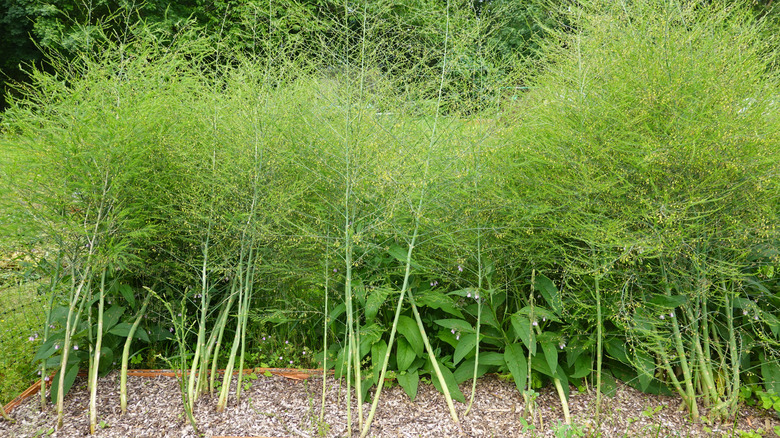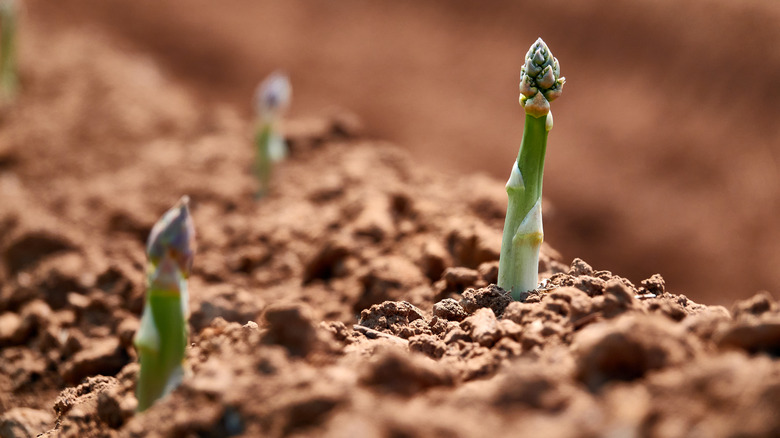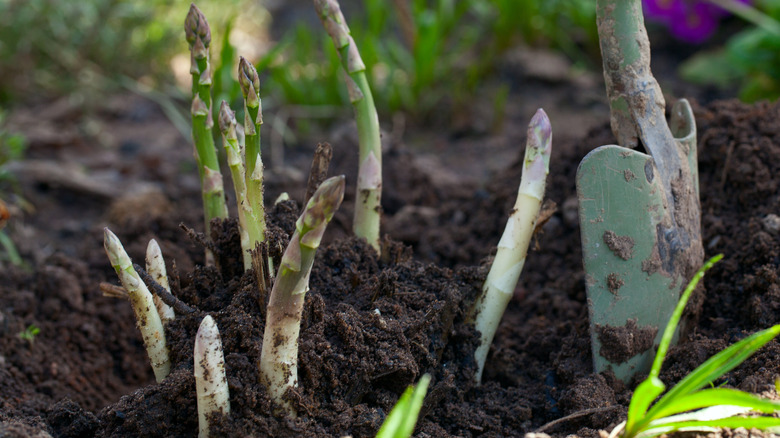Crucial Mistakes You're Making When Growing Asparagus In Your Garden
Asparagus is one of the most delicious vegetables around. Even better, it's in season in spring, much earlier than many other veggies. While asparagus is often quite expensive at grocery stores, it's surprisingly easy to grow in your home garden. Of course, it still has its challenges, and there are some common mistakes you need to avoid if you want to be able to enjoy asparagus year after year. Some of the biggest errors people make when growing asparagus include growing it in a spot that doesn't have the right light and soil conditions, not watering or fertilizing it correctly, ignoring signs of disease, and harvesting too much or when the plant is too young.
Asparagus is impressively cold hardy and can be grown in USDA zones 2 through 9; however, it does require full sun to thrive. Failing to plant your asparagus in a sunny spot can end your growing journey before it even begins. While you may be able to get away with growing asparagus in a partially shaded location, don't expect it to be as productive as plants growing in full sun.
Wrong soil and poor irrigation are asparagus killers
Soil that is prone to waterlogging can quickly cause the crowns and roots to rot, as asparagus thrives in a moist but well-draining growing medium. You can add compost and other amendments, if necessary, to improve your soil's drainage before planting. While asparagus appreciates sandy soil, you can grow it in clay-heavy soil too, as long as you've made sure it drains well.
A balanced fertilizer is generally appropriate for asparagus, but it's a good idea to perform a soil test before planting. The soil test will tell you if you'll need to add fertilizer while also measuring the pH of your soil. Asparagus requires a pH between 6.5 and 7.0 to grow its best and struggles in overly acidic soil. If necessary, fix soil imbalances with amendments to create a more hospitable location for the asparagus plants. Don't forget to mulch the asparagus so it doesn't lose too much water to evaporation.
Since asparagus prefers moist soil, stay on top of watering when rainfall is scarce. The plants should ideally receive about an inch or more of water per week. Sufficient water is especially important during the first year, while the plants are still getting established. Don't worry about watering your asparagus during the winter when it's dormant; however, make sure it gets plenty of water during spring while you're harvesting it. The sandier the soil, the more often you should water it.
Ignoring diseases and harvesting incorrectly can doom your asparagus
While asparagus is often a very healthy crop, it's not immune to pests and disease. Some people opt to use companion planting to keep pests away from their asparagus in the garden. In addition to threats from pests like beetles and aphids, asparagus can be vulnerable to problems like Fusarium rot and asparagus rust. These diseases are caused by fungi, and once your garden bed is contaminated, you should avoid growing asparagus there for several years. Acting quickly and removing infected plants may spare at least some of your crops, while ignoring the problem is likely to leave you with few, if any, asparagus plants left.
Asparagus is easy to harvest: Just cut the shoots, cook them up, and enjoy. However, it's important to avoid harvesting your asparagus during its first year or two, while it's still getting established. Even once your asparagus is mature, you should stop harvesting it for the season after the end of June or if you notice the spears becoming thin. Excessive harvesting can weaken the plant, resulting in a worse harvest in the following years.


